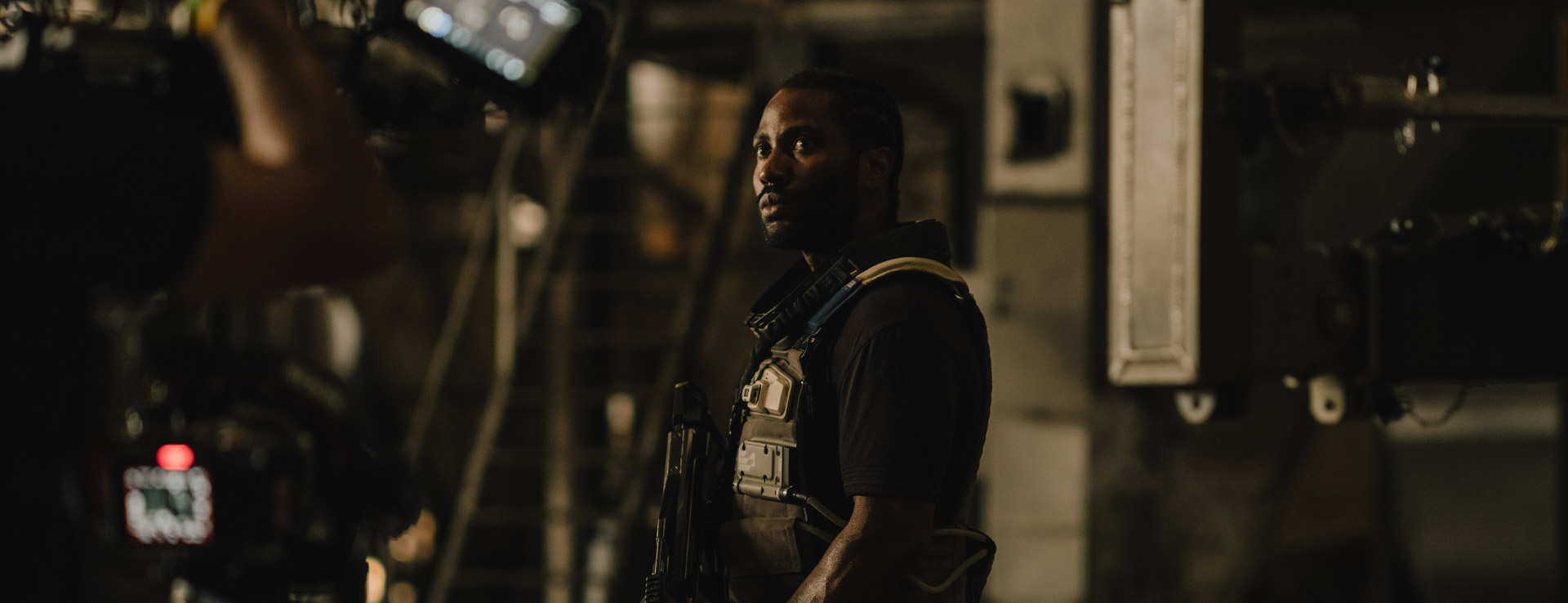How Gareth Edwards and ILM’s Jay Cooper Went DIY for The Creator
“I was going to do a robot film no matter what.”
It wasn’t something Gareth Edwards planned. He loved grounded science fiction and was intrigued by artificial intelligence. Looking to step back into the director’s chair for the first time since 2016’s Rogue One: A Star Wars Story, he began kicking around a story idea that would eventually become The Creator — an original tale that finds the US banning and at war with “simulants,” or AI-powered robots.
“The Holy Trinity of science fiction is spaceships, alien monsters, robots. And I’ve done a spaceship movie. I’d done a monster movie twice. It was like, ‘I want to do a robot film.’ So I was going to do a robot film no matter what,” Edwards tells Lucasfilm.com. “In my head, I was like, ‘I want to do that next if I can.’” But as production started, science fiction was moving increasingly into the realm of science fact.
“I remember driving to set, someone must have texted me that whistleblower story from Google or whatever, and it was basically they’d leaked their conversation with the AI that they thought was sentient. I got totally distracted reading this conversation and, by the end of it, I was like everyone else. I was like, ‘This feels alive,’” Edwards says. “I thought AI was something that could easily not happen in my lifetime, and now it’s happening so fast that where it was a year ago, to think what it’s going to be in a few years is kind of mind blowing.” By the time the movie was released in summer 2023, AI — the good, the bad, and the ugly — had become the topic of the day. The technology had arrived, and The Creator seemed impossibly timely.




In addition to its relevance to a very real issue, The Creator is also unique in, well, its uniqueness. Original IP of this scale in movies is becoming less frequent, making the project a different kind of opportunity for all involved. Edwards’ partner in realizing the world of The Creator would be Industrial Light & Magic, and both parties relished the chance to stretch themselves creatively. “I think it’s wonderful whenever you can do something that’s different and new and you’re charting your own course. That’s really exciting,” says Jay Cooper, visual effects supervisor. “That’s pretty rare. That’s rare for me and rare for us in visual effects land. Not to bash any small movies that had their origins in 1977, but there are a lot of movies that have a very set story and design language that’s very much established. So it was nice to do something that was original and really exciting and challenging at the same time, because you’re figuring it out.”
Edwards wanted The Creator to have a mechanical look, with a decidedly retro-future aesthetic. Collaborating with production designer James Clyne, he turned away from the elegance of today’s mobile devices and instead looked to the tech of his youth, especially when it came to the simulants. “The idea was that with these robots, it was like Apple have not won. The Sony Walkman has won the tech war in the future,” Edwards says. “So we were riffing off a lot of product design from the ‘80s and ‘90s, but coming at it from two angles. You can either take a non-living organism like a product and try to anthropomorphize it and make it have eyes and be a character, and that can only get you so far. Or you could take a living organism like an insect, like a praying mantis or something, and then you try and turn it into the Walkman version of that. And we found both ways doing both kind of work for us.” This led to several variations of simulants, from those that appear almost human (minus a cybernetic back of head), to fully metal-and-plastic beings with visible cables and gears, to walking garbage-can-like bombs.
A lot has been made of the relatively small budget ($80 million) for The Creator, considering its impressive visual effects and overall scope. As Edwards and Cooper tell it, the secret was scaling things down behind the scenes — a tactic no doubt helped by Edwards’ background in visual effects, as he started his career as a VFX artist. There were limited tracking markers, no mo-cap suits, a smaller video village, no HDRI balls. Edwards himself would operate the camera, along with cinematographers Greig Fraser and Oren Soffer. The production shot mostly on location over Southeast Asia, including Thailand, Vietnam, and Japan, avoiding green screen whenever possible. In other words, it was indie filmmaking brought to the studio level.
“Well, I think in terms of visual effects, basically ILM were a bit suicidal with it because it was a stupid thing to do — agree to a filmmaker coming in saying, ‘I want to do this backwards. I don’t want to chase concept art. I don’t want to shoot green screen. I want to go to real-world locations, shoot lots of hopefully beautiful photography with great performances and all that. And then in the edit we’ll decide what the world looks like and who is a robot,’” Edwards says, half-jokingly. “And so there was this blind agreement of, ‘Okay, well, it’ll be roughly these number of shots with this sort of ambition.’ I honestly expected ILM to go, ‘Look, we’re very flattered that you came and asked us, and maybe there’s another project…’ You know what I mean? I kept waiting for the day they were going to call and say, ‘We can’t do this. This is just not a sustainable business model.’ But thankfully, Jay’s insane.”




“Yeah, I want that title: suicidal visual effects supervisor. That’d be a good one. Or maybe it’s ‘masochistic,’” Cooper quips. “Well, I mean, we partnered with Gareth from the start. We knew what his ambition was and we were really excited by the fact that this was not a traditional process. We agreed to some ground rules along the way that we would try to keep the number of iterations down.” Indeed, takes were kept to a minimum, and Edwards and Cooper would negotiate what could be done after a shot — move this tank, change the angle of that spaceship — and move on. As mentioned, Edwards chose which extras would be a simulant, almost randomly, when reviewing scenes. This resulted in some very human-acting robotic beings — like when a live grenade causes one to panic, or another just lounges in a chair.



“There’s something really exciting, I thought, about having really naturalistic behavior,” he says. “So, basically, we didn’t tell anyone when we were filming — we didn’t say who was a robot and who was AI in the movie, we just told everyone that it’s a sci-fi movie. You might end up as a robot, but you’re a human in your head. Even if you are a robot, that’s what you’re doing. Please forget this is science fiction. Imagine it’s a contemporary war film. And off we go.”
“There’s some fun shots that are kind of throwaway, like the robot unwrapping the candy bar for the kid,” Cooper says. “I can guarantee that there’s no other movie that has tried to do that same thing.” In the end, it seems as if Edwards’ and Cooper’s unorthodox approach to The Creator has paid off. The film won five categories at the 22nd annual Visual Effects Society Awards, including Outstanding VFX in a Photoreal Feature, and at press time is nominated for Best Visual Effects at the 96th Academy Awards.






The Creator follows former US operative Joshua who comes to be the protector of Alfie, a next-gen AI in the form of a young girl. As the pair make their journey through various lands, Edwards wanted viewers taking in the environments and people (human or not) on their own terms. So not everything onscreen, like robot monks, has an explanation. “I think great science fiction doesn’t have all the answers,” he says. “The second you understand everything, it’s not the future.”
When it comes to answers regarding AI, Edwards doesn’t pretend to have those either. But The Creator is very sympathetic to the simulants; Lucasfilm.com asks if the movie is his statement on how we should feel about the technology.
“It’s my statement on anything, really, in that I genuinely do think — to get profound for a second — with all wars or any conflict, it’s really a lack of empathy to see something from the other perspective. We’ve evolved not to do that. We’ve evolved to fight over that watering hole and kill the other tribe, otherwise we wouldn’t be here. So we have that hardwired, but you have to stop yourself and go, ‘Wait a minute. This is no more our watering hole than it’s their watering hole,” he says. “I think stories are little mini versions of these dilemmas and how to get through life. That’s what I think about. My favorite science fiction has meat on the bone. It’s about something beyond spaceships and robots.”
The Creator is now streaming on Hulu and available on 4K UHD Blu-ray, Blu-ray, DVD, and digital.
Behind-the-scenes photos by Oren Soffer.
Dan Brooks is a writer and the senior editor of StarWars.com and Lucasfilm.com. Follow him on X at @dan_brooks and Instagram at @therealdanbrooks.






